Soccer newsletter: This is what the USMNT needs to fix to avoid a qualifying disaster
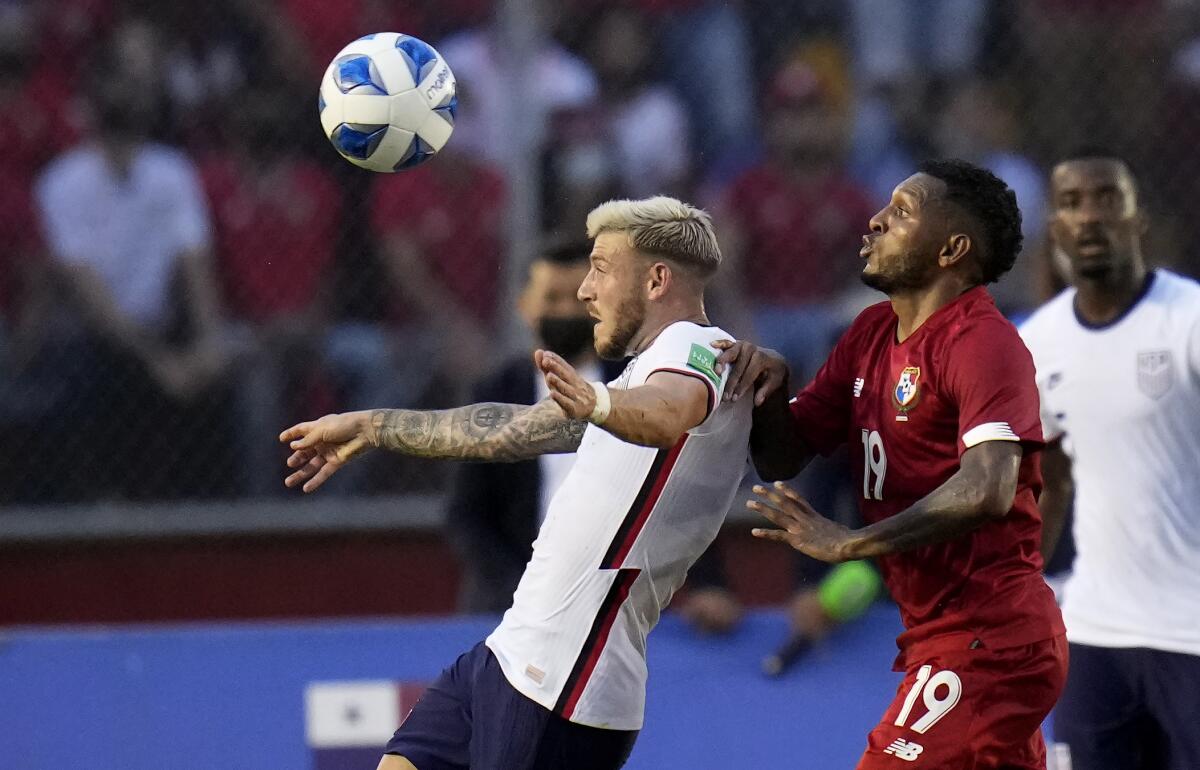
COLUMBUS, Ohio — Hello and welcome to the L.A. Times soccer newsletter. I’m Kevin Baxter, the Times’ soccer writer, and we start today with World Cup qualifying, where the alarm bells are faint but audible for the U.S. after Sunday’s uninspired, unorganized and uncreative 1-0 loss to Panama, a result that is more a warning than cause for full-blown panic.
But if left uncorrected, the problems the loss exposed could quickly spiral out of control.
The U.S. was unable to dictate pace against Panama, something that has plagued the team through most of the first five qualifiers. It was all but invisible in the midfield, couldn’t play wide and failed to match Panama’s energy and physicality.
“A lot of it was confidence to play with the ball,” defender Walker Zimmerman said.
“It never felt like we could get in a rhythm with possession to have the composure to keep the ball, move the ball, move them around, make them run. So that hurt us.”
“It’s sports, it’s humans,” said coach Gregg Berhalter, whose team lost for the first time in 14 games. “There’s no one explanation for it. Panama, we talked about being a very physical team, very difficult team to break down. And that’s exactly what they were.
“We just didn’t do that enough. We didn’t have that 100% today.”
They better find it soon. The Americans’ next game, the third in seven days, is Wednesday against Costa Rica. After that comes Mexico, in the first game of the November qualifying window.
But there are also deeper, more fundamental problems to correct.
For all the team’s supposed depth, the U.S. has looked dangerously thin in qualifying. Christian Pulisic and Gio Reyna, the top two offensive threats, have missed more games than they’ve played because of injuries and fitness issues while Weston McKennie, the team’s top midfielder, has missed three of the five games after being suspended for violating the team’s COVID-19 protocols.
Ricardo Pepi, 18, and Brenden Aaronson, 20, have stepped up in their absence. In the 130 minutes the two have played together, the U.S. has scored six times, with Pepi getting three goals and two assists and Aaronson a goal and an assist.
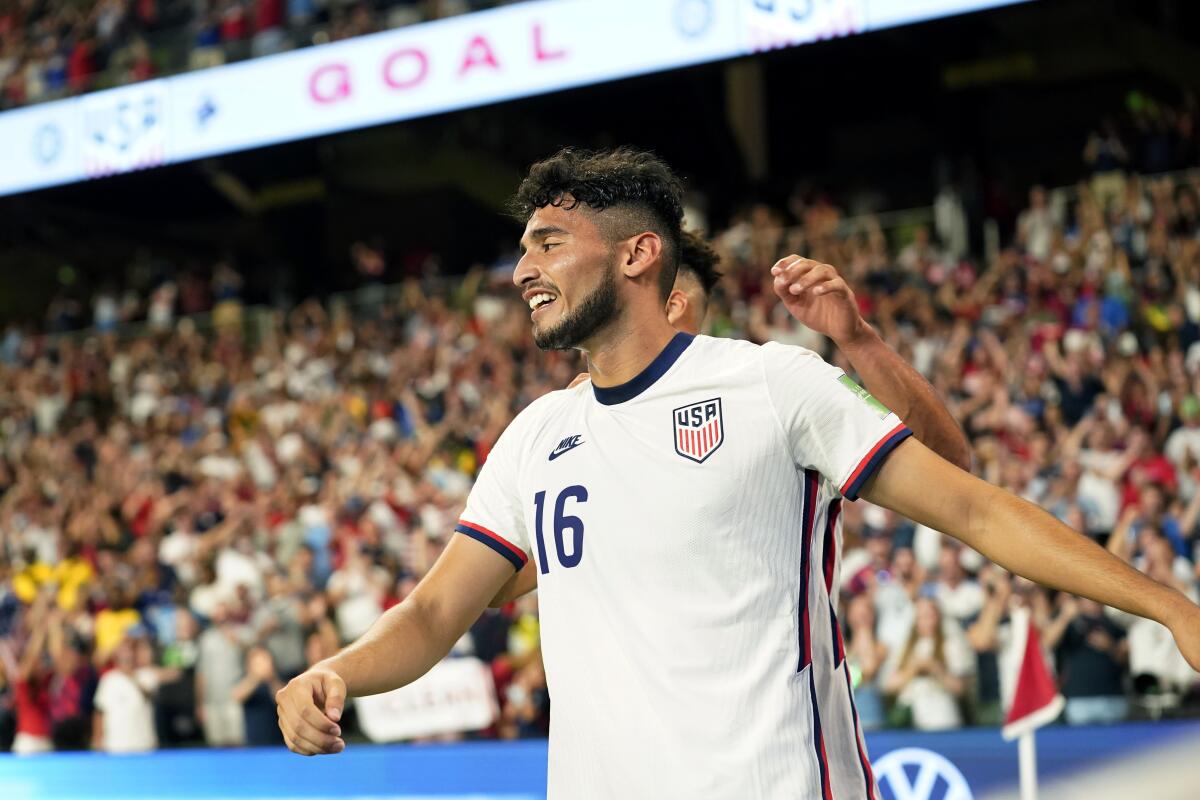
The U.S. has scored just once in the other 320 qualifying minutes.
Sunday, with Pepi on the bench, Berhalter started the oldest lineup he has used in the qualifying tournament. With three games in seven days, Berhalter gambled, rotating his lineup by making seven changes to the team he started in a victory over Jamaica.
It was a gamble he lost. The U.S. was dreadful, especially in the midfield. With McKennie unavailable and Tyler Adams playing just a half, Panama ran through, around and over the Americans. And with no one to bring the ball up into the attack, the U.S. managed just five shots, none on goal. Statistically, it was the worst offensive performance in the Berhalter Era.
But it’s a disaster that has been building for some time. The U.S. hasn’t scored in the first half in any of its last eight games; that hasn’t happened in more than 30 years. And it has multiple goals in just five of the last 15.
That sputtering offense leaves the team with a margin for error that is just too thin. And when the errors are as major as the ones the U.S. committed Sunday, they can’t be overcome.
Enjoying this newsletter? Consider subscribing to the Los Angeles Times
Your support helps us deliver the news that matters most. Become a subscriber.
The return of Pulisic and Reyna in November should help. McKennie, Antonee Robinson and Sergiño Dest, who all sat out the Panama game, are expected to play against Costa Rica. That will undoubtedly help, too.
But the U.S. is also lacking for grit and determination and that will be harder to solver. Berhalter’s team has shown little fight in the qualifiers, especially against the physical Panamanians. Fighting for the crest has long been a hallmark of the U.S. national team, but it’s one that’s sometimes been lacking in the last two World Cup cycles.
Three of the Americans’ first five qualifiers where in the heat and humidity of Central America and the team collected four of a possible nine points. Four of the next six are at home, where the U.S. has won 31 of 37 games with CONCACAF opponents since the start of the last qualifying cycles in 2016.
With a win over Costa Rica, the U.S. can move back atop the qualifying table. Faintly the alarm bells are ringing. But there’s no need to panic — yet.
“The good thing is, we’re still in second place, right?” Berhalter asked at the end of Sunday’s post-game news conference. “So our goal is to go into Wednesday’s game and get three points.
“We take every game as it comes and Wednesday’s another opportunity to get three points and further establish our position.”
CONCACAF World Cup qualifying table
Pts. W L T
Mexico 11 3 0 2
U.S. 8 2 1 2
Panama 8 2 1 2
Canada 7 1 0 4
Costa Rica 6 1 1 3
El Salvador 5 1 2 2
Honduras 3 0 2 3
Jamaica 2 0 2 3
Results
THURSDAY
U.S. 2, Jamaica 0
Honduras 0, Costa Rica 0
Mexico 1, Canada 1
El Salvador 1, Panama 0
SUNDAY
Panama 1, U.S. 0
Jamaica 0, Canada 0
Costa Rica 2, El Salvador 1
Mexico 3, Honduras 0
Oct. 13
U.S. vs. Costa Rica, Columbus, Ohio
Canada vs. Panama
Honduras vs. Jamaica
El Salvador vs. Mexico
National team dilemma
Speaking of the U.S. national team, one player who won’t be wearing that uniform again is Galaxy defender Julian Araujo, who last week announced he would continue his international career with Mexico after FIFA approved a one-time change of association.
If history is any guide, it may not turn out the way Araujo hopes.
He isn’t the first U.S.-born dual national to be the subject of a contentious tug of war between the U.S. and Mexico. In 2017, both sides pursued Californian Jonathan González, a U.S. youth international, who wound up choosing Mexico and making his debut the following January in a friendly.
He has played just 73 minutes for Mexico since, and none of those minutes have come in the last two years. He’s also yet to appear in a competitive match.
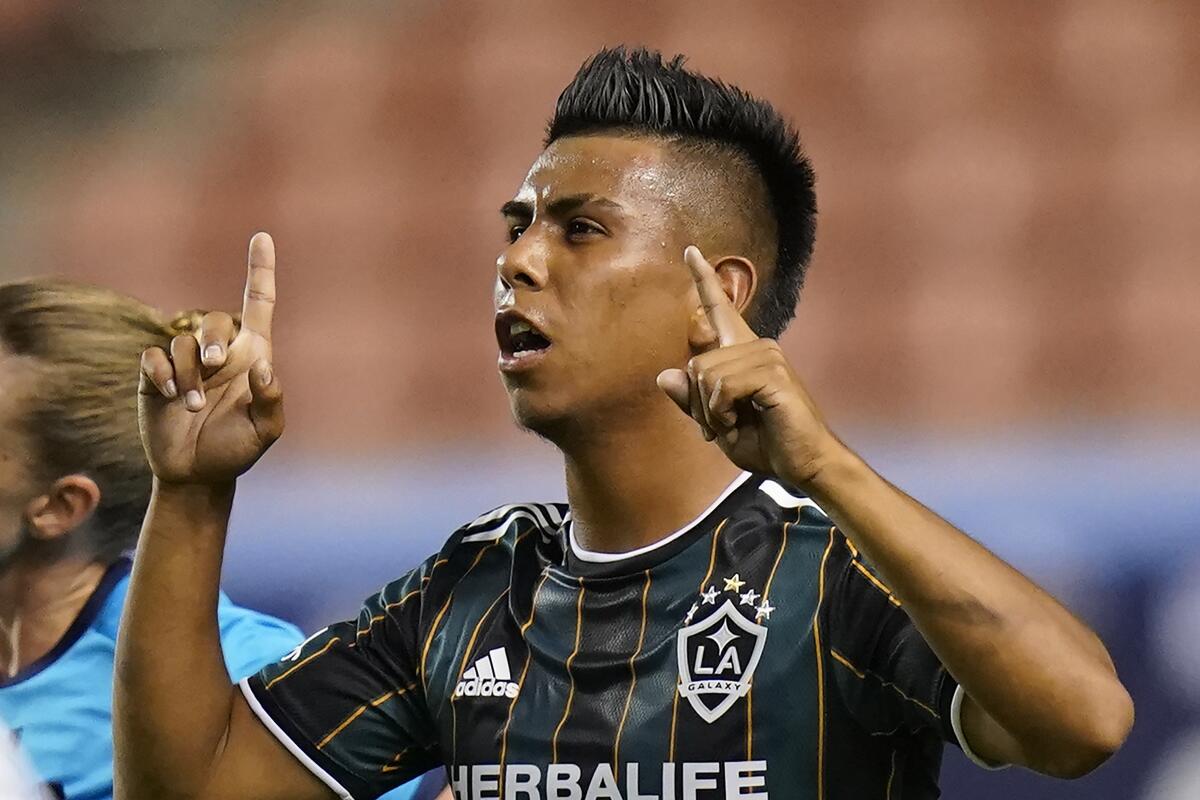
More recently Galaxy midfielder Efraín Álvarez of Los Angeles, who played for age-group national teams on both sides of the border, announced he would continue his senior career with Mexico. He has appeared in four games as a substitute for El Tri since March but has not been called up for any World Cup qualifiers. He was followed by Real Salt Lake goalkeeper David Ochoa of Oxnard, who picked Mexico last August, two months after suiting up for the U.S. against El Tri in the Nations League final.
Now comes Araujo, who interested Mexico but may not fit in the team’s immediate plans. In fact, one could make the argument Mexico is more concerned about drawing players to its side not to play them, but to keep them from playing for the U.S.
International soccer isn’t like the club game; Mexico doesn’t have to pay its players if it doesn’t call them up. And since changes of affiliation generally are one-time things, they can’t be undone. So Gonzalez, Álvarez and Araujo are locked in with Mexico — and can’t play for the U.S. — whether they’re ever called up or not.
Now compare that to Berhalter’s use of dual nationals who chose the U.S. Pepi, who was eligible to play for the U.S. and Mexico, picked the U.S. on Aug. 26 and less than two weeks later he was starting in a World Cup qualifier, in which he scored a goal and added two assists. He scored two more times in last week’s win over Jamaica
Clearly the chances for making an impact in meaningful games is greater with the U.S. than with Mexico and has been for some time — which is why Richie Ledezma, Rubio Rubin, Sebastian Soto and Uly Llanez also stayed with the U.S.
If Araujo is called up by Mexico for the next round of qualifiers in November, his first game could come against the U.S. in Cincinnati. But he faces stiff competition at right back with Gerardo “Tata” Martino starting Jorge Sánchez and Luis Rodríguez in the last two World Cup qualifiers.
On the other hand the Mexican team is far older — Rodríguez is 30 — and in need of a makeover while the young U.S. team has several right-back candidates under the age of 25. That could work in Arajuo’s favor long-term.
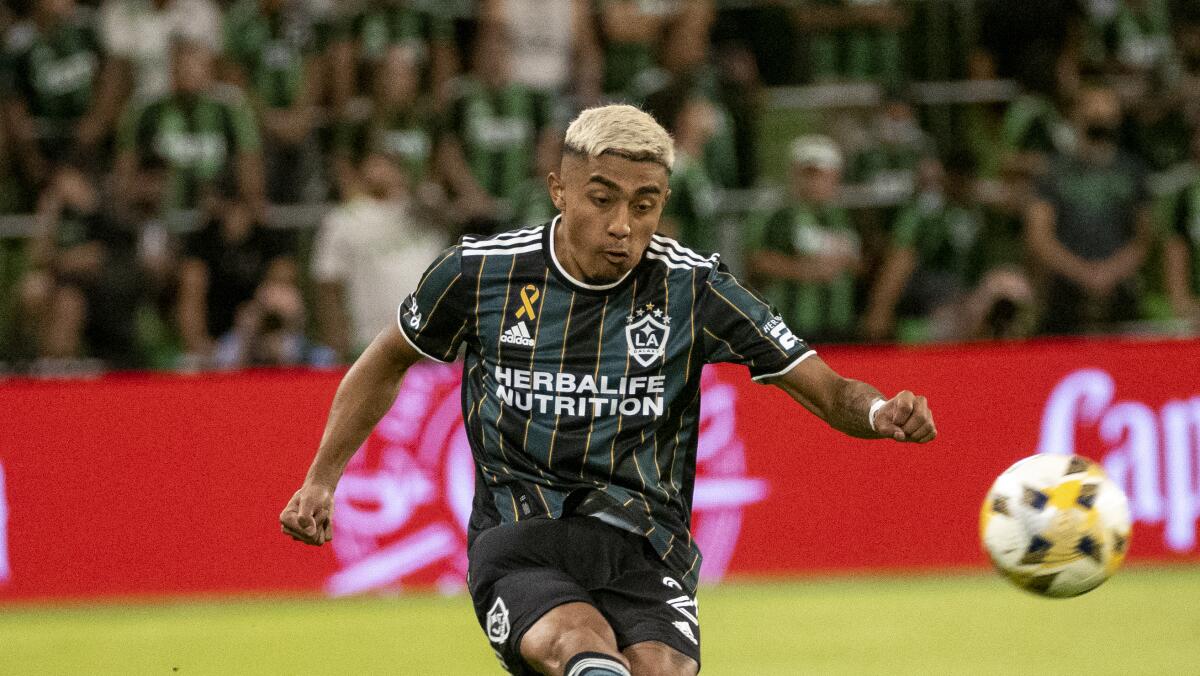
Harder to overcome will be the aversion of many in Mexico to non-native-born players suiting up for the national team. That’s something Araujo, who was born to Mexican parents in Lompoc, can do nothing to change.
“I still think that the coach of the national team should be a Mexican and that the players of the Mexican national team should be Mexican,” said Brazilian-born coach Ricardo “El Tuca” Ferretti who, despite his misgivings, served as interim manager of El Tri three times.
The most recent flashpoint for that kind of thinking came last summer when Martino’s Gold Cup roster included Rogelio Funes Mori, an Argentine by birth and a naturalized Mexican citizen. Luis Hernández, the fourth-leading scorer in national team history, took to Twitter to support Henry Martin.
“Let’s go @HenryMartinM f***ing get in!! So that they don’t call up any foreigners!!!” he wrote.
Martin went to the Tokyo Olympics as an overage player and Funes Mori scored a team-high three goals in leading Mexico to the Gold Cup final.
Araujo, in a social media post announcing his change of affiliation, stressed his heritage and a youth spent watching the Mexican national team on TV.
“I’m proud to be a Mexican American and being raised in a Mexican American household is a privilege for which I am forever grateful,” he wrote. “Growing up watching the Mexican national team in the World Cup was a unifying moment for my family. Watching them inspired me to pursue a dream of playing professional soccer.
“My heart is still with Mexico.”
Araujo had a wealth of people, in addition to his parents, who were well-positioned to advise him. Teammates Jonathan dos Santos, Álvarez and Javier “Chicharito” Hernández have played for Mexico, while Sebastian Lletget, Araujo’s best friend on the Galaxy, plays for the U.S. Galaxy general manager Dennis te Kloese also worked for years with the Mexican national federation while Araujo’s agent Henry Codron also represents Ochoa, who announced his change of affiliation in an emotional story essay in The Players’ Tribune.
“Coming from a family of farm workers, I was instilled with the values of hard work, dedication and resilience,” Araujo wrote in his social media post. “Thanks to the sacrifices that my family and I have put in on and off the pitch, I have the confidence to make this decision today.”
But will he regret it tomorrow?
Stat watch
0: Number of saves for LAFC goalkeeper Jamal Blackman in two MLS starts
2: Number of goals Blackman has conceded
24: Number of MLS teams, out of 27, that had players called up by their national teams during this month’s FIFA fixture window
24: Number of minutes, out of a possible 810, the Galaxy have held a lead during their nine-game winless streak
0: Shots on goal by the U.S. national team in Sunday’s loss in Panama, the fewest in the Americans’ last 28 World Cup qualifiers, according to statistician Paul Carr.
Carr also suggested the U.S. stop playing on Oct. 10. In the last six years, the U.S. senior national team has played three times on that date. It lost to Panama in a qualifier on Sunday; lost to Trinidad and Tobago in the final qualifier in 2017, which cost it a trip to the World Cup; and lost the CONCACAF Cup to Mexico in 2015. The U-23 team also was eliminated from the Olympic qualifying tournament on Oct. 10, 2015.
One more stint with the Galaxy?
Last week’s unveiling of a Landon Donovan statue in Legends Plaza outside the southwest entrance to Dignity Health Sports Park inspired the former Galaxy great to not only reflect on his past, but to think about his future as well.
And it’s a future he hopes will lead him back to the club with which he spent 11 seasons. Donovan, in his second year as manager of the San Diego Loyal in the USL Championship, already has been publicly linked to one MLS coaching job. But the team he really wants to work for doesn’t have an opening.
“In a perfect world, one day far down the road, it could be for the Galaxy,” he said of managing in MLS. “With someone as accomplished as Greg [Vanney] there, I would expect that he’s going to be there for a long time. And he should.
“But hopefully, at one point, [I] will be in in Galaxy colors again. That would certainly be a dream come true in this new part of my life.”
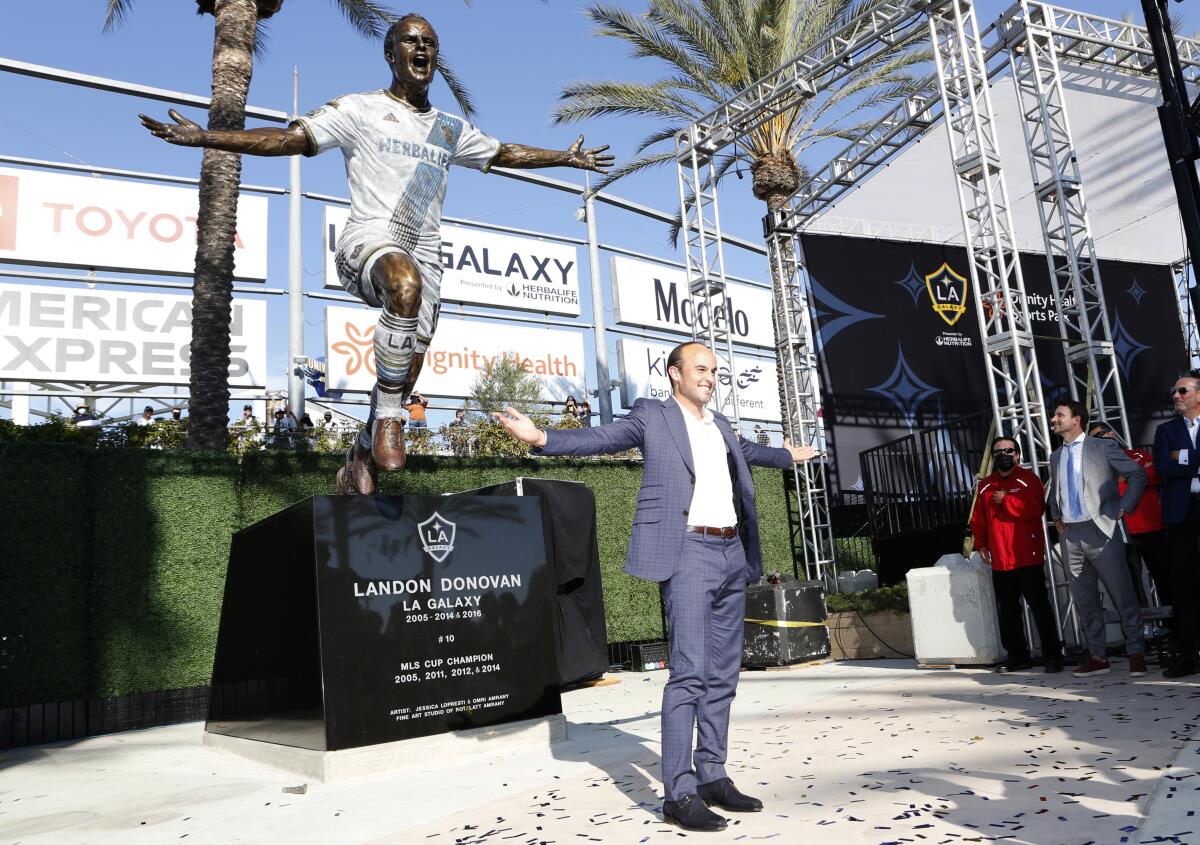
Donovan, 39, broke MLS records for career goals, assists and league championships while wearing a Galaxy uniform and won four of his six titles, in addition to two Supporters’ Shields, in Southern California. That’s why commissioner Don Garber named the league MVP award after him. But he also won two MLS Cups for the San Jose Earthquakes and played for legendary European clubs Everton, Bayern Munich and Bayer Leverkusen before retiring with León in Mexico’s Liga MX.
If Donovan had been a baseball player instead of just a baseball fan, he’d be asked to choose a cap from among those half-dozen teams for his Hall of Fame plaque. Soccer players don’t wear caps, of course, but Donovan was asked if they did, would he pick a Galaxy cap when he enters the National Soccer Hall of Fame?
“There’s no question, yeah,” he said. “I had a great stint at Everton. I really enjoyed the time at Bayern Munich. I loved being a part of the Earthquakes; that’s where I really became a professional, a man, in a lot of ways,” he said. “But the heart of my career is with the Galaxy and it’s the club I am unequivocally most associated with.”
And finally there’s this …
Mohammed bin Salman, the crown prince of Saudi Arabia, is the man behind the Saudi Public Investment Firm’s recent purchase of Premier League Newcastle United for $415 million. The investment firm’s estimated net worth of $430 billion makes it the richest club ownership group in the world, according to Goal.com. The seventh-richest owner, by the way, is the Galaxy’s Philip Anschutz. Goal puts his net worth at $10 billion, ahead of Arsenal’s Stan Kroenke, who also owns the NFL’s Rams, and Nasser Al-Khelaifi of Paris Saint-Germain.
Quotebook
“The best part of being Mexican American is that I carry two flags. It is one of the things about myself that brings me great pride.”
Galaxy forward Julian Araujo announcing his decision to play internationally for Mexico
Until next time...
Stay tuned for future newsletters. Subscribe here, and I’ll come right to your inbox. Something else you’d like to see? Email me. Or follow me on Twitter: @kbaxter11.
Go beyond the scoreboard
Get the latest on L.A.'s teams in the daily Sports Report newsletter.
You may occasionally receive promotional content from the Los Angeles Times.




